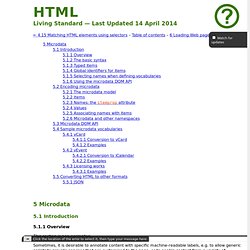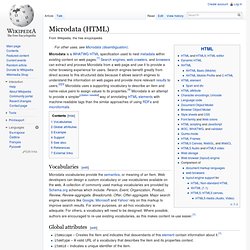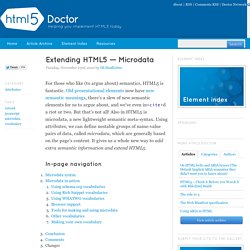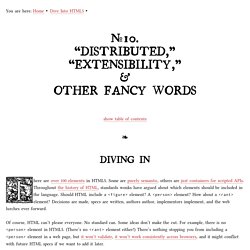

5 Microdata. Microdata 5.1 Introduction 5.1.1 Overview This section is non-normative.

Sometimes, it is desirable to annotate content with specific machine-readable labels, e.g. to allow generic scripts to provide services that are customised to the page, or to enable content from a variety of cooperating authors to be processed by a single script in a consistent manner. For this purpose, authors can use the microdata features described in this section. 5.1.2 The basic syntax At a high level, microdata consists of a group of name-value pairs. To create an item, the itemscope attribute is used. To add a property to an item, the itemprop attribute is used on one of the item's descendants. Here there are two items, each of which has the property "name": <div itemscope><p>My name is <span itemprop="name">Elizabeth</span>.
Markup without the microdata-related attributes does not have any effect on the microdata model. ConceptNet 5. SemWebTec is a community for semantic web researchers. Microformats. Structured Data Testing Tool. Microdata (HTML) Microdata is a WHATWG HTML specification used to nest metadata within existing content on web pages.[1] Search engines, web crawlers, and browsers can extract and process Microdata from a web page and use it to provide a richer browsing experience for users.

Search engines benefit greatly from direct access to this structured data because it allows search engines to understand the information on web pages and provide more relevant results to users.[2][3] Microdata uses a supporting vocabulary to describe an item and name-value pairs to assign values to its properties.[4] Microdata is an attempt to provide a simpler[citation needed] way of annotating HTML elements with machine-readable tags than the similar approaches of using RDFa and microformats. Microdata vocabularies provide the semantics, or meaning of an Item. Web developers can design a custom vocabulary or use vocabularies available on the web. Here is the same markup with added Schema.org[5][6][7] Microdata:
Extending HTML5 — Microdata. For those who like (to argue about) semantics, HTML5 is fantastic.

Old presentational elements now have new semantic meanings, there’s a slew of new semantic elements for us to argue about, and we've even in<cite>d a riot or two. But that's not all! Also in HTML5 is microdata, a new lightweight semantic meta-syntax. Using attributes, we can define nestable groups of name-value pairs of data, called microdata, which are generally based on the page’s content.
It gives us a whole new way to add extra semantic information and extend HTML5. Let’s go through these new attributes and see how to use them in practice with everyone’s favourite example band, Salter Cane. Microdata syntax # itemscope and itemprop # <p itemscope>I’m going to the <span itemprop="name">Salter Cane</span> gig next week.Excited! The presence of itemscope on the <p> element makes it into a microdata item. Itemprop names can be words or URL strings.
Itemprop value from an attribute # Nested items # Multiple properties # Person. Microdata. You are here: Home Dive Into HTML5 Diving In There are over 100 elements in HTML5.

Some are purely semantic, others are just containers for scripted APIs. Throughout the history of HTML, standards wonks have argued about which elements should be included in the language. Should HTML include a <figure> element? Of course, HTML can’t please everyone. Right, so if making up your own elements isn’t the answer, what’s a semantically inclined web author to do? Microformats and RDFa each have their strengths and weaknesses.
What is Microdata? Each word in the following sentence is important, so pay attention. Professor Markup Says. Web Developer Tutorial: HTML5 Microdata. The HTML5 draft specification includes Microdata.

The Microdata spec provides a standardized syntax for additional semantic markup to your web pages to enhance the machine readability of your web pages. It’s purpose isn’t to make a new widget appear on your web page but to help automated programs like google understand and better handle the content of your web pages. HTML5 Microdata has the same basic mission as RDFa and Microformats but differs slightly in implementation and use.
HTML5 microdata allows you at add structured markup to any HTML element that is bot-readable, standardized and won’t cause any problems with browsers that don’t support it. As browsers add real support for HTML5 microdata, you will see an explosion of tools to enable faster data entry, collection and better accessibility options for people with disabilities.